Physical Address
304 North Cardinal St.
Dorchester Center, MA 02124
Impingement is derived from the Latin verb impingere, meaning “to force against,” where an anatomic structure becomes entrapped causing pain, bony and soft tissue injury, decreased range of motion, and dysfunction. When impingement occurs, one bone repetitively strikes another, which over time can stimulate the deep layer of the periosteum to form osteophytes that further exacerbate the impingement and alter the normal mechanics of the ankle joint. Osseous or bony impingement most commonly occurs following spur formation along the anterior margin of the distal tibia and talus or as a result of a prominent posterolateral talar process—the os trigonum (OT). Soft tissue impingement usually results from scarring and fibrosis associated with synovial, capsular, or ligamentous injury and most often occurs in the anterolateral gutter, the medial ankle, or in the region of the syndesmosis. Conservative treatment such as activity modification and retraining should be aimed at breaking this repetitive cycle in order to decrease the inflammation and provide relief. However, the sporting limitations are often limiting, and if conservative management fails, surgery is usually indicated.
Obtain adequate exposure and visualization prior to attempting removal, to ensure complete excision
Careful placement of skin incisions in order to avoid painful neuromas and hypersensitive scars.
The surgeon should be meticulous with osteophyte removal. Care should be taken to remove all of the impinging osteophyte. Intraoperative fluoroscopy can be utilized to confirm complete removal.
Studies have shown that preoperative computed tomography (CT) scan may improve the characterization of the osteophytes and lead to more complete removal at the time of surgery.
In order to understand and appropriately manage ankle impingement conditions, one must first understand the anatomy of the ankle joint. The talus articulates inferiorly with the os calcis, and the talar axis is in line with the first web space of the foot, while the axis of the os calcis is in line with the fourth web space ( Fig. 2.1 ). In dorsiflexion, bony impingement occurs anteromedially between the neck of the talus and the anterior lip of the tibia. In plantarflexion, bony impingement occurs posterolaterally between the os calcis and the posterior lip of the tibia. Therefore, anteromedial and posterolateral impingement is usually bony in nature while anterolateral and posteromedial impingement is usually a soft tissue condition. Impingement conditions are most commonly seen in the anterior ankle; however, they can also occur in all quadrants of the ankle joint, including anterior, lateral, posterior, and medial.
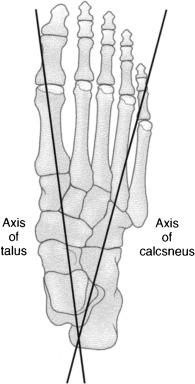
Anterior ankle impingement is relatively common in the athlete. Repetitive forced dorsiflexion can lead to frequent impaction injuries as the talar neck and hypertrophied synovial tissue impinge on the anterior lip of the tibia leading to the formation of osteophytes over time. Recurrent supination injuries in the form of inversion ankle sprains, seen in chronic ankle instability, can also cause inflammation and hypertrophic changes of the synovium between the talus and tibia. If the instability is not addressed, synovitis and scar tissue will accumulate most commonly in the anterolateral gutter leading to pain, swelling, continued impingement and lateral column overload, and stress fractures ( Figs 2.2, 2.3 ). Anteromedial ankle impingement occurs when the anterior portion of the medial malleolus impinges against a spur on the medial shoulder of the talus. The medial joint spurs form following injuries to the deltoid ligamentous complex. In addition, the anterior tibiotalar ligament becomes thickened and can impinge on the anteromedial corner of the talus. Patients typically complain of anteromedial joint line pain, which is aggravated by walking and running as well as planting and pivoting during sporting activities. They also report medial clicking and limited, painful dorsiflexion. Patients often have anteromedial ankle swelling and pain over the anterior aspect of the deltoid ligament, and the spur can often be palpated on physical exam. Anterior osteophytes are often seen on standard lateral weight-bearing plain x-rays. The “plié view,” which is a lateral weight-bearing view in maximal dorsiflexion, can be useful to demonstrate anterior impingement. With regards to the anteromedial talar and tibial bone spurs, plain anteroposterior and lateral radiographs can often miss these osteophytes. Studies have shown that spurs over 7 mm in size can be missed in these locations due to projectional issues and the relative positions of the lateral talar neck and body and anterolateral tibia. An oblique anteromedial impingement view (AMI) can be obtained by plantar-flexing the foot and externally rotating the leg to 30 degrees with the x-ray beam tilted 45 degrees cranial. This view has been shown to be especially useful in detecting anteromedial bone spurs. During arthroscopy, the anteromedial ankle should be adequately visualized and inspected for the presence of an impingement spur, which should be debrided when present. Holding the ankle in dorsiflexion will help with visualization and any required debridement.
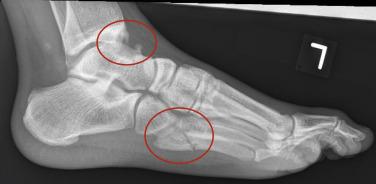
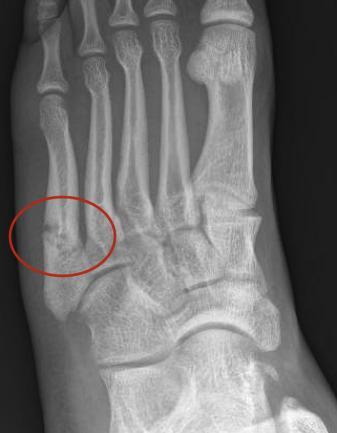
Another form of anterior impingement was described by Amendola et al., as cam-type impingement of the ankle, similar to the impingement that has previously been described in the femoral neck. This form of impingement occurs when the sagittal contour of the talar dome forms a non-circular arc with anterior talar flattening and creates pathologic contact with the anterior aspect of the tibial plafond with the ankle in dorsiflexion ( Fig. 2.4 ). On lateral weight-bearing foot x-rays, the cam ratio is measured by drawing a line under the lateral process of the talus parallel to a line drawn along the navicular, cuneiform, and metatarsal bones. From this line, the widest and narrowest portions of the talus are measured distal to the apex of the talar dome ( Fig. 2.5 ). The cam ratio is then determined by dividing the narrowest point by the widest. The α-angle is determined for both the medial and lateral talar domes. A circle is drawn to match the curvature of the tibial plafond. This circle is then overlayed with the curvature of the talar domes. The α-angle is positive when the radius of the talar dome exceeds the radius of the circle anteriorly. The authors found that the medial dome was most prominent and anterior in cases of impingement. The authors also found that cam-type ankles were associated with higher cam ratios and positive α sign when compared to control ankles. The authors suggest that if unrecognized and untreated, cam-type impingement, like femoroacetabular impingement, can lead to recurrence as well as degenerative arthritic changes.
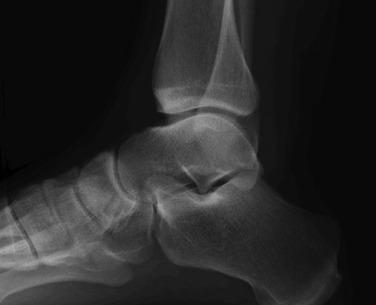
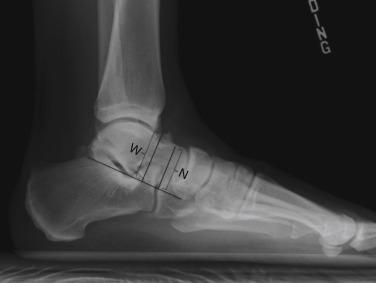
Anterocentral impingement is the classic location when describing anterior ankle impingement. The locations of the spurs have been described in four typical patterns:
Spurs found primarily on the lip of the tibia. This type is ideal for arthroscopic management. Under direct vision, the impinging lip of the distal tibia can be easily removed with a burr or thin osteotome. The osteophyte is removed while holding the ankle in maximal dorsiflexion while using an osteotome with blunt edges to avoid damaging the dome of the talus.
Spurs found primarily on the talus. This pattern of impingement is more difficult to treat with only an arthroscopic technique. The osteophytes are typically found within the capsular insertion on the talar neck, and it becomes necessary to strip the capsule distally in order to visualize the pathology. In addition, the osteophytes are easily missed, and therefore intraoperative imaging may be needed to ensure adequate removal.
Spurs are present on both the lip of the tibia and the talar neck. This pattern is also associated with loose bodies that have broken off the osteophytes. This pattern is common and the most technically challenging. Surgical management often involves arthroscopy with an associated mini arthrotomy.
Multiple anterior osteophytes are present secondary to advanced ankle osteoarthritis. The benefit of arthroscopic debridement in these cases is questionable and should probably not be performed.
Become a Clinical Tree membership for Full access and enjoy Unlimited articles
If you are a member. Log in here